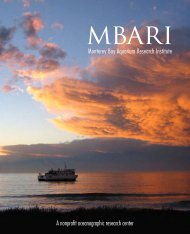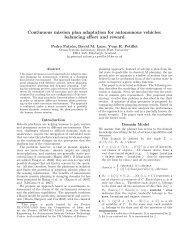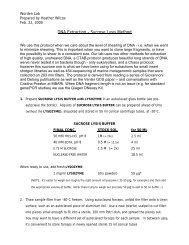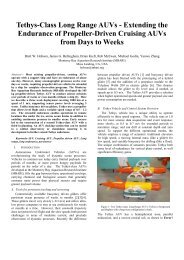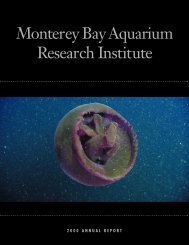Detecting, Tracking and Classifying Animals in Underwater Video
Detecting, Tracking and Classifying Animals in Underwater Video
Detecting, Tracking and Classifying Animals in Underwater Video
Create successful ePaper yourself
Turn your PDF publications into a flip-book with our unique Google optimized e-Paper software.
<strong>Detect<strong>in</strong>g</strong>, <strong>Track<strong>in</strong>g</strong> <strong>and</strong> <strong>Classify<strong>in</strong>g</strong> <strong>Animals</strong> <strong>in</strong> <strong>Underwater</strong> <strong>Video</strong><br />
Duane R. Edg<strong>in</strong>gton<br />
Ishbel Kerkez<br />
Danelle E. Cl<strong>in</strong>e<br />
Dorothy Oliver<br />
Monterey Bay Aquarium Research Institute,<br />
7700 S<strong>and</strong>holdt Road,<br />
Moss L<strong>and</strong><strong>in</strong>g, CA 95039, USA<br />
{duane, ikerkez, dcl<strong>in</strong>e, doliver}@mbari.org<br />
Abstract<br />
We demonstrate an attentional event selection, track<strong>in</strong>g,<br />
<strong>and</strong> classification system for process<strong>in</strong>g video streams<br />
from remotely operated underwater vehicles (ROVs) that<br />
enables automated annotation of underwater video<br />
transects for quantitative studies of ocean ecology. The<br />
system identifies <strong>and</strong> tracks potentially <strong>in</strong>terest<strong>in</strong>g visual<br />
events spann<strong>in</strong>g multiple frames based on low-level<br />
properties of salient objects. “Interest<strong>in</strong>g” events are<br />
passed to a Bayesian classifier utiliz<strong>in</strong>g a Gaussian<br />
mixture model to determ<strong>in</strong>e the abundance <strong>and</strong><br />
distribution of a representative benthic species.<br />
Presented data details the comparison between<br />
automated detection of organisms <strong>and</strong> program<br />
classification of deep-sea ocean bottom ech<strong>in</strong>oderm (sea<br />
star) Rathbunaster californicus <strong>in</strong> video footage with<br />
professional annotations.<br />
1. Background <strong>and</strong> summary of work<br />
For more than a century, the traditional approach for<br />
assess<strong>in</strong>g the k<strong>in</strong>ds <strong>and</strong> numbers of animals <strong>in</strong> the oceanic<br />
water column was to tow collection nets beh<strong>in</strong>d ships.<br />
This method is limited <strong>in</strong> its spatial resolution. Today,<br />
ROVs provide an excellent alternative to nets for<br />
obta<strong>in</strong><strong>in</strong>g quantitative data on the distribution <strong>and</strong><br />
abundance of oceanic animals [1]. Us<strong>in</strong>g video cameras,<br />
it is possible to make quantitative video transects (QVT)<br />
through the water, provid<strong>in</strong>g high-resolution data at the<br />
scale of the <strong>in</strong>dividual animals <strong>and</strong> their natural<br />
aggregation patterns that advance studies <strong>in</strong> animal<br />
diversity, distribution <strong>and</strong> abundance. However, the<br />
current manual method of analyz<strong>in</strong>g QVT video by<br />
tra<strong>in</strong>ed scientists is very labor <strong>in</strong>tensive <strong>and</strong> poses a<br />
serious limitation to the amount of <strong>in</strong>formation that can<br />
be obta<strong>in</strong>ed from ROV dives.<br />
To overcome this bottleneck <strong>in</strong> analyz<strong>in</strong>g underwater<br />
videos we have developed an automated system for<br />
detect<strong>in</strong>g <strong>and</strong> classify<strong>in</strong>g animals (events) visible <strong>in</strong> the<br />
Marc’Aurelio Ranzato 1<br />
Pietro Perona 2<br />
1 New York University, NY, NY, USA<br />
(ranzato@cs.nyu.edu)<br />
2 California Institute of Technology,<br />
Computations <strong>and</strong> Neural Systems Program,<br />
Pasadena, CA 91125, USA (perona@caltech.edu)<br />
video stream. This task is difficult due to the low contrast<br />
of many translucent animals <strong>and</strong> due to debris (“mar<strong>in</strong>e<br />
snow”) clutter<strong>in</strong>g the scene. We process video frames<br />
with an attentional selection algorithm [2] that has been<br />
shown to work robustly for target detection <strong>in</strong> a variety of<br />
natural scenes [3].<br />
The c<strong>and</strong>idate locations identified by the attentional<br />
selection module are tracked across video frames us<strong>in</strong>g<br />
l<strong>in</strong>ear Kalman Filters [4]. If objects can be tracked<br />
successfully over several frames, they are stored as<br />
potentially “<strong>in</strong>terest<strong>in</strong>g” events. Based on low-level<br />
properties, <strong>in</strong>terest<strong>in</strong>g events are identified <strong>and</strong> marked <strong>in</strong><br />
the video frames. Interest<strong>in</strong>g events are then processed by<br />
a classification module tra<strong>in</strong>ed to classify specific animal<br />
categories.<br />
The demonstrated attentional selection, track<strong>in</strong>g <strong>and</strong><br />
classification modules are our first steps towards an<br />
<strong>in</strong>tegrated automated video annotation system. Our work<br />
enables follow-on development of automated ocean<br />
observatory cameras with pan/tilt/zoom control <strong>and</strong><br />
automated process<strong>in</strong>g of video from cameras on<br />
autonomous underwater vehicles.<br />
2. Explanation of the algorithms<br />
Four ma<strong>in</strong> process<strong>in</strong>g steps are <strong>in</strong>volved <strong>in</strong> our video<br />
event detection analysis procedure after the video has<br />
been captured from the digital BetaCam video deck used<br />
for record<strong>in</strong>g the HDTV signal from the ROVs. Initially,<br />
some generic pre-process<strong>in</strong>g is performed for each frame<br />
of the <strong>in</strong>put video stream (background subtraction, scan<br />
l<strong>in</strong>e smooth<strong>in</strong>g, global contrast enhancement); then the<br />
vic<strong>in</strong>ity of locations are scanned for the occurrence of<br />
animals at which the Kalman Filter trackers predict them;<br />
thirdly, every five frames the image is processed to f<strong>in</strong>d<br />
salient objects that are not yet tracked; <strong>and</strong> <strong>in</strong> the last<br />
step, visual events are classified <strong>in</strong>to “<strong>in</strong>terest<strong>in</strong>g” or<br />
“bor<strong>in</strong>g” accord<strong>in</strong>g to low-level properties of the tokens<br />
<strong>in</strong>volved.
<strong>Track<strong>in</strong>g</strong> is achieved with two l<strong>in</strong>ear Kalman Filters<br />
for the x <strong>and</strong> y coord<strong>in</strong>ates of each tracked object,<br />
assum<strong>in</strong>g that the motion of the image of the object <strong>in</strong> the<br />
camera plane has constant acceleration. This is a good<br />
assumption for constant speed head<strong>in</strong>g motion of ROVs<br />
obta<strong>in</strong><strong>in</strong>g QVTs. Data assignment for our multiple target<br />
track<strong>in</strong>g (MTT) system is done by a nearest-neighbor rule<br />
[5]. The Kalman trackers are <strong>in</strong>itiated with salient objects<br />
detected by a system mimick<strong>in</strong>g saliency-based bottomup<br />
attention <strong>in</strong> humans <strong>and</strong> other primates [2, 6].<br />
For this saliency-based detection system, each <strong>in</strong>put<br />
frame is decomposed <strong>in</strong>to seven channels (<strong>in</strong>tensity<br />
contrast, red/green <strong>and</strong> blue/yellow double color<br />
opponencies, <strong>and</strong> the four canonical, spatial orientations)<br />
at six spatial scales, yield<strong>in</strong>g 42 “feature maps”. After<br />
iterative spatial competition for salience with<strong>in</strong> each map,<br />
only a sparse number of locations rema<strong>in</strong> active, <strong>and</strong> all<br />
maps are comb<strong>in</strong>ed <strong>in</strong>to a unique “saliency map”. The<br />
saliency map is scanned by the focus of attention <strong>in</strong> order<br />
of decreas<strong>in</strong>g saliency, through the <strong>in</strong>teraction between a<br />
w<strong>in</strong>ner-take-all neural network (which selects the most<br />
salient location at any given time) <strong>and</strong> an <strong>in</strong>hibition-ofreturn<br />
mechanism (transiently suppress<strong>in</strong>g the currently<br />
attended location from the saliency map) [2]. Each<br />
scanned location is compared with the events that are<br />
already be<strong>in</strong>g tracked. If it does not belong to any of these<br />
events, a new tracker for the detected object is <strong>in</strong>itiated.<br />
For each tracked object, we obta<strong>in</strong> a b<strong>in</strong>ary mask,<br />
which allows us to extract a number of low-level<br />
properties such as the object size, the second moments<br />
with respect to the centroid, the maximum lum<strong>in</strong>ance<br />
<strong>in</strong>tensity, the average lum<strong>in</strong>ance <strong>in</strong>tensity over the shape<br />
of the object, <strong>and</strong> its aspect ratio. We use the mask to<br />
extract a subframe of the event for further process<strong>in</strong>g.<br />
For classification, we pass these segmented square<br />
subframes to a Bayesian classifier [7] that extracts<br />
features us<strong>in</strong>g local jets from a labeled tra<strong>in</strong><strong>in</strong>g set, <strong>and</strong><br />
classifies with a Gaussian mixture model to determ<strong>in</strong>e the<br />
abundance <strong>and</strong> distribution of a representative benthic<br />
organisms.<br />
3. Results<br />
In NTSC s<strong>in</strong>gle frames obta<strong>in</strong>ed from midwater dives of<br />
ROVs (ROV Tiburon <strong>and</strong> Ventana) <strong>in</strong> which human<br />
observers could identify one or more animals, the most<br />
salient (first attended) location found by the attention<br />
algorithm co<strong>in</strong>cides with an animal <strong>in</strong> about 90% of the<br />
cases. The process<strong>in</strong>g of midwater video clips shows<br />
similarly promis<strong>in</strong>g results[8]. For epibenthic (near<br />
bottom) transects, the system detects 97% of the deep-sea<br />
benthic ech<strong>in</strong>oderm Rathbunaster californicus <strong>in</strong> video<br />
footage, <strong>and</strong> correctly classifies those events as<br />
Rathbunaster californicus <strong>in</strong> 90% of the events.<br />
In our demonstration, we show unprocessed video<br />
clips to illustrate the nature of the task, <strong>and</strong> we show<br />
processed video clips with marked “<strong>in</strong>terest<strong>in</strong>g” events<br />
concurrently. In addition, we will have one computer<br />
display<strong>in</strong>g the process<strong>in</strong>g steps <strong>in</strong> real time while runn<strong>in</strong>g<br />
the algorithm. We will display a poster with explanations<br />
of the background <strong>and</strong> significance of our research; we<br />
will show details of the process<strong>in</strong>g steps, as well as<br />
performance data that compare the automated detection<br />
<strong>and</strong> classification method with human annotators.<br />
Presented data details the comparison between automated<br />
program classification of Rathbunaster californicus <strong>in</strong><br />
video footage with professional annotations.<br />
Our demonstration is an example of apply<strong>in</strong>g<br />
computer vision algorithms to real-world video data, of<br />
broad <strong>in</strong>terest s<strong>in</strong>ce our work can be adapted <strong>and</strong><br />
extended to other areas such as surveillance <strong>and</strong> robotic<br />
control.<br />
Acknowledgements<br />
This project orig<strong>in</strong>ated at the 2002 Workshop for<br />
Neuromorphic Eng<strong>in</strong>eer<strong>in</strong>g <strong>in</strong> Telluride, CO, USA. We<br />
thank the David <strong>and</strong> Lucile Packard Foundation for their<br />
generous support of research <strong>and</strong> development at<br />
MBARI. At MBARI, Karen A. Salamy provided<br />
technical assistance, <strong>and</strong> Michael Risi eng<strong>in</strong>eered our<br />
video capture system.<br />
References<br />
1. Robison, B.H., The coevolution of undersea vehicles <strong>and</strong><br />
deep-sea research. Mar<strong>in</strong>e Technology Society Journal,<br />
2000. 33: p. 69-73.<br />
2. Itti, L., C. Koch, <strong>and</strong> E. Niebur, A model of saliency-based<br />
visual attention for rapid scene analysis. IEEE Transactions<br />
on Pattern Analysis <strong>and</strong> Mach<strong>in</strong>e Intelligence, 1998. 20(11):<br />
p. 1254-1259.<br />
3. Itti, L. <strong>and</strong> C. Koch. Target Detection us<strong>in</strong>g Saliency-Based<br />
Attention. <strong>in</strong> Proc. RTO/SCI-12 Workshop on Search <strong>and</strong><br />
Target Acquisition (NATO Unclassified). 1999. Utrecht, The<br />
Netherl<strong>and</strong>s.<br />
4. Kalman, R.E. <strong>and</strong> R.S. Bucy, New Results <strong>in</strong> L<strong>in</strong>ear<br />
Filter<strong>in</strong>g <strong>and</strong> Prediction Theory. Journal of Basic<br />
Eng<strong>in</strong>eer<strong>in</strong>g, 1961. 83(3): p. 95-108.<br />
5. Kirubarajan, T., Y. Bar-Shalom, <strong>and</strong> K.R. Pattitipati,<br />
Multiassignment for <strong>Track<strong>in</strong>g</strong> a Large Number of<br />
Overlapp<strong>in</strong>g Objects. IEEE Transactions on Aerospace <strong>and</strong><br />
Electronic Systems, 2001. 37(1): p. 2-21.<br />
6. Itti, L. <strong>and</strong> C. Koch, Computational modell<strong>in</strong>g of visual<br />
attention. Nature Reviews Neuroscience, 2001. 2(3): p. 194-<br />
203.<br />
7. Ranzato, M.A., http://www.vision.caltech.edu/ranzato/.<br />
2004, California Institute of Technology: Pasadena, CA.<br />
8. Walther, D., D.R. Edg<strong>in</strong>gton, <strong>and</strong> C. Koch. Detection <strong>and</strong><br />
<strong>Track<strong>in</strong>g</strong> of Objects <strong>in</strong> <strong>Underwater</strong> <strong>Video</strong>. <strong>in</strong> IEEE<br />
International Conference on Computer Vision <strong>and</strong> Pattern<br />
Recognition (CVPR). 2004. Wash<strong>in</strong>gton, D.C.


